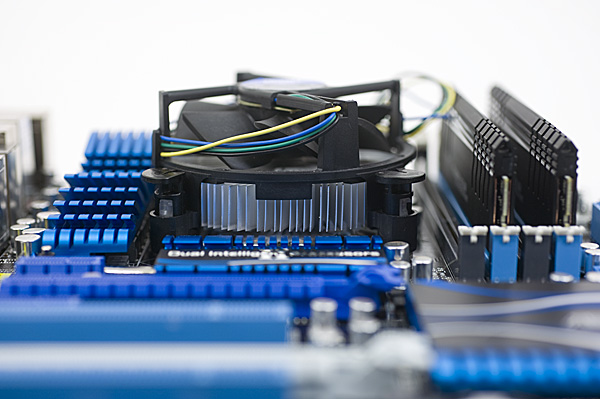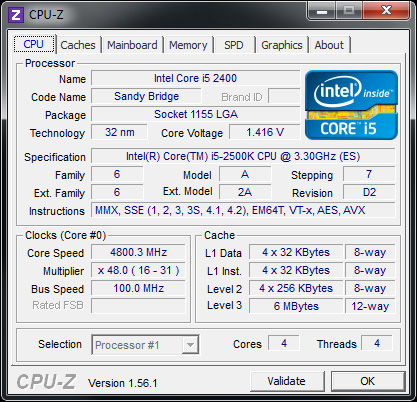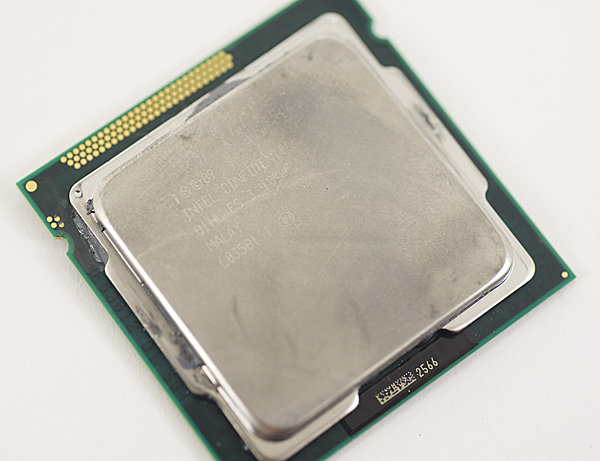The Sandy Bridge Review: Intel Core i7-2600K, i5-2500K and Core i3-2100 Tested
by Anand Lal Shimpi on January 3, 2011 12:01 AM ESTOverclocking, the K-Series and What You’ll Want to Buy
If you haven’t noticed, the computing world is becoming more integrated. We review highly integrated SoCs in our smartphone coverage, and even on the desktop we’re seeing movement towards beefy SoCs. AMD pioneered the integrated memory controller on desktop PCs, Intel followed suit and with Lynnfield brought a PCIe controller on-die as well. Sandy Bridge takes the next logical step and brings a GPU on-die, a move matched by AMD with Brazos and Llano this year.
In the spirit of integration, Intel made one more change this round: the 6-series chipsets integrate the clock generator. What once was a component on the motherboard, the PLL is now on the 6-series chipset die. The integrated PLL feeds a source clock to everything from the SATA and PCIe controllers to the SNB CPU itself. With many components driven off of this one clock, Intel has locked it down pretty tight.
With Nehalem and Westmere, to overclock you simply adjusted the BCLK from 133MHz to whatever speed you wanted and sometimes toyed with multipliers to arrive at a happy end result. With Sandy Bridge, the BCLK generated on the 6-series PCH is at 100MHz by default and honestly won’t go much higher than that.
While I’ve heard reports of getting as high as 115MHz, I’d view 103—105MHz as the upper limit for what you’re going to get out of BCLK overclocking. In other words: next to nothing. A 105MHz BCLK overclock on a Core i7-2600 will take you from a stock speed of 3.4GHz to a whopping 3.57GHz. The form of overclocking we’ve been using for the past decade is effectively dead on Sandy Bridge.
Years ago, before the Pentium II, we didn’t rely on BCLK (or back then it was just FSB or bus overclocking) to overclock. Back then, if we wanted a faster CPU we’d just increase the clock multiplier. Intel has dabbled in offering multiplier unlocked parts for overclockers, we saw this last year with the Core i7 875K for example. With Sandy Bridge, those unlocked parts are going to be a lot more important to overclockers.
It works like this. If you have a part that does not support Turbo (e.g. Core i3-2100 series), then your CPU is completely clock locked. You can’t overclock it at all, have fun at your stock frequency. This is good news for AMD as it makes AMD even more attractive at those price points.
If you have a part that does support turbo (e.g. Core i5-2400), then you have what’s called a “limited unlocked” core—in other words you can overclock a little bit. These parts are limited to an overclock of 4 processor bins above and beyond the highest turbo frequency. Confused yet? This chart may help:
In this case we’re looking at a Core i5-2500, which runs at 3.3GHz by default. When a single core is active, the chip can turbo up to 3.7GHz. If you want, you can change that turbo state to go as high as 4.1GHz (if your CPU and cooling can keep up).
Overclocking these limited unlocked chips relies entirely on turbo however. In the case above, the fastest your chip will run is 4.1GHz but with only one core active. If you have four cores active the fastest your chip can run is 3.8GHz. While Intel didn’t sample any limited unlocked parts, from what I’ve heard you shouldn’t have any problems hitting these multiplier limits.
There’s a third class of part: a fully unlocked K-series chip. At launch there are only two of these processors: the Core i5-2500K and the Core i7-2600K. Anything with a K at the end of it means you get all multipliers from 16x all the way up to 57x at your disposal. It’s effectively fully unlocked.

These chips overclock very well. Both my Core i5-2500K and Core i7-2600K hit ~4.4GHz, fully stable, using the stock low-profile cooler.

This is all you need for 4.4GHz
With a bit more effort and a better cooler, you can get anywhere in the 4.6-5.0GHz range:

It's a bit too early to tell how solid these near-5GHz overclocks will be, but I'm confident in the sub-4.5GHz overclocks we were able to sustain.
You do pay a price premium for these K-series SKUs. The 2500K will cost you another $11 over a stock 2500 and the 2600K costs an extra $23. In the case of the 2500K, that’s a small enough premium that it’s honestly worth it. You pay $11 extra for a chip that is very conservatively clocked and just begging for you to overclock it. Even the 2600K’s premium isn’t bad at all.
| Model Number | Standard SKU | K-Series SKU | Price Premium |
| Intel Core i7-2600 | $294 | $317 | +$23 |
| Intel Core i5-2500 | $205 | $216 | +$11 |
As an added bonus, both K-series SKUs get Intel’s HD Graphics 3000, while the non-K series SKUs are left with the lower HD Graphics 2000 GPU.
Compared to Lynnfield, you’re paying $11 more than a Core i5-760 and you’re getting around 10-45% more performance, even before you overclock. In a perfect world I’d want all chips to ship unlocked; in a less perfect world I’d want there to be no price premium for the K-series SKUs, but at the end of the day what Intel is asking for here isn’t absurd. On the bright side, it does vastly simplify Intel’s product stack when recommending to enthusiasts: just buy anything with a K at the end of it.
Since we’re relying on multiplier adjustment alone for overclocking, your motherboard and memory actually matter less for overclocking with Sandy Bridge than they did with P55. On both P67 and H67, memory ratios are fully unlocked so you can independently set memory speed and CPU speed. Even the GPU ratios are fully unlocked on all platforms and fully independent from everything else.












283 Comments
View All Comments
dgingeri - Monday, January 3, 2011 - link
I have a really good reason for X58: I/OI have 2X GTX 470 video cards and a 3Ware PCIe X4 RAID controller. None of the P67 motherboards I've seen would handle all that hardware, even with cutting the video cards' I/O in half.
This chip fails in that one very important spot. if they had put a decent PCIe controller in it, with 36 PCIe lanes instead of 16, then I'd be much happier.
Exodite - Monday, January 3, 2011 - link
That's exactly why this is the mainstream platform, while x58 is the enthusiast one, though. Your requirements aren't exactly mainstream, indeed they are beyond what most enthusiasts need even.sviola - Monday, January 3, 2011 - link
You may want to look at the Gigabyte GA-P67A-UD5 and GA-P67A-UD7 as they can run your configuration.Nihility - Monday, January 3, 2011 - link
Considering the K versions of the CPUs don't have it.If I'm a developer and use VMs a lot, how important will VT-d be within the 3-4 years that I would own such a chip?
I know that it basically allows direct access to hardware and I don't want to get stuck without it, if it becomes hugely important (Like how you need VT-x to run 64 bit guests).
Any thoughts?
code65536 - Monday, January 3, 2011 - link
My question is whether or not that chart is even right. I'm having a hard time believing that Intel would disable a feature in an "enthusiast" chip. Disabling features in lower-end cheaper chips, sure, but in "enthusiast" chips?! Unless they are afraid of those K series (but not the non-K, apparently?) cannibalizing their Xeon sales?has407 - Monday, January 3, 2011 - link
Relatively unimportant IMHO if you're doing development. If you're running a VM/IO-intensive production workload (which isn't likely with one of these), then more important.Remember, you need several things for Vt-d to work:
1. CPU support (aka "IOMMU").
2. Chip-set/PCH support (e.g., Q57 has it, P57 does not).
3. BIOS support (a number of vendor implementations are broken).
4. Hypervisor support.
Any of 1-3 might result in "No" for the K parts. Even though it *should* apply only to the CPU's capabilities, Intel may simply be saying it is not supported. (Hard to tell as the detailed info isn't up on Intel's ark site yet, and it would otherwise require examining the CPU capability registers to determine.)
However, it's likely to be an intentional omission on Intel's part as, e.g., the i7-875K doesn't support Vt-d either. As to why that might be there are several possible reasons, many justifiable IMHO. Specifically, the K parts are targeted at people who are likely to OC, and OC'ing--even a wee bit, especially when using VT-d--may result in instability such as to make the system unusable.
If Vt-d is potentially important to you, then I suggest you back up through steps 4-1 above; all other things equal, 4-2 are likely to be far more important. If you're running VM/IO-intensive workloads where performance and VT-d capability is a priority, then IMHO whether you can OC the part will be 0 or -1 on the list of priorities.
And while VT-d can make direct access to hardware a more effective option (again, assuming Hypervisor support), it's primary purpose is to make all IO more efficient in a virtualized environment (e.g., IOMMU and interrupt mapping). It's less a matter of "Do I have to have it to get to first base?" than "How much inefficiency am I willing to tolerate?" And again, unless you're running IO-intensive VM workloads in a production environment, the answer is probably "The difference is unlikely to be noticeable for the work [development] I do."
p.s. code65536 -- I doubt Intel is concerned with OC'd SB parts cannibalizing Xeon sales. (I'd guess the count of potentially lost Xeon sales could be counted on two hands with fingers to spare.:) Stability is far more important than pure speed for anyone I know running VM-intensive loads and, e.g., no ECC support on these parts is for me deal killer. YMMV.
DanNeely - Tuesday, January 4, 2011 - link
For as long as MS dev tools take to install, I'd really like to be able to do all my dev work in a VM backed up to the corporate lan to ease the pain of a new laptop and to make a loaner actually useful. Unfortunately the combination of lousy performance with MS VPC, and the inability of VPC to run two virtual monitors of different sizes mean I don't have a choice about running visual studio in my main OS install.mino - Wednesday, January 5, 2011 - link
VMware Workstation is what you need. VPC is for sadists.Even if your budget is 0(zero), and VPC is free, KVM/QEMU might be a better idea.
Also, Hyper-V locally and (via RDP) is pretty reasonable.
cactusdog - Monday, January 3, 2011 - link
If we cant overclock the chipset how do we get high memory speeds of 2000Mhz+? Is there still a QPI/Dram voltage setting?Tanel - Monday, January 3, 2011 - link
No VT-d on K-series? FFFFUUUU!So just because I want to use VT-d I'll also be limited to 6 EUs and have no possibility to overclock?
Then there's the chipset-issue. Even if I got the enthusiast targeted K-series I would still need to get the:
a) ...H67-chipset to be able to use the HD-unit and QS-capability - yet not be able to overclock.
b) ...P67-chipset to be able to overclock - yet to lose QS-capability and the point of having 6 extra EUs as the HD-unit can't be used at all.
What the hell Intel, what the hell! This makes me furious.